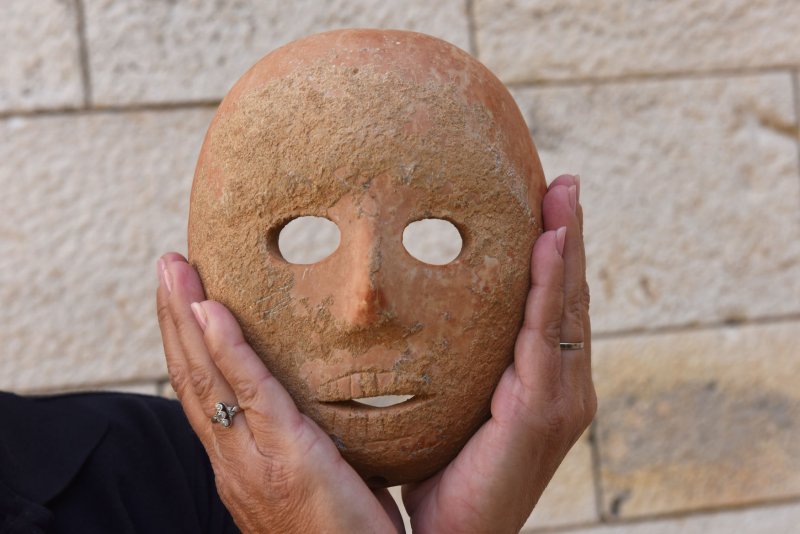1 of 2 | Ronit Lupu of the Israeli Antiquities Authority Antiquities Theft Prevention Unit, holds a rare 9,000 year old stone mask that was uncovered in the south Hebron hills, at the Rockefeller Archeology Museum in East Jerusalem, November 28, 2018. Photo by Debbie Hill/UPI |
License Photo
Nov. 28 (UPI) -- Archaeologists have recovered an ancient limestone mask from Israel's Hebron Hills, located on the West Bank. The 9,000-year-old mask dates to the Neolithic period, offering insights to the cultural traditions of the regions earliest agricultural societies.
"Stone masks are linked to the agricultural revolution," Omry Barzilai, head of the archaeological research department at the Israel Antiquities Authority, said in a news release. "The transition from an economy based on hunting and gathering to ancient agriculture and domestication of plants and animals was accompanied by a change in social structure and a sharp increase in ritual-religious activities. Ritual findings from that period include human shaped figurines, plastered skulls, and stone masks."
The mask was found and excavated several months ago, but its discovery was announced Wednesday by Barzilai and his colleagues. Researchers with the IAA and the Geological Survey of Israel have spent the past several months analyzing the artifact. The results of their study will be shared on Thursday at the Israel Prehistoric Society annual meeting.
The limestone mask is pinkish-yellow and expertly carved to create smooth contours closely resembling a human face. Four holes in the mask would have allowed it to be tied, perhaps to a pole or a human face.
"Discovering a mask made of stone, at such a high level of finish, is very exciting," said Ronit Lupu of the IAA. "The stone has been completely smoothed over and the features are perfect and symmetrical, even delineating cheek bones. It has an impressive nose and a mouth with distinct teeth."
The newly unearthed mask is one of 15 similar artifacts. However, the majority of Neolithic masks were identified in private collections. The Hebron Hills mask was recovered directly from an archeological dig site.
"The mask is a unique finding in the archaeological world. It is even more unusual that we know which site it came from," Lupu said. "The fact that we have information regarding the specific place in which it was discovered makes this mask more important than most other masks from this period that we currently know of."
Researchers think ancestor worship was commonly practiced by early agricultural peoples, and the newly discovered mask was likely used in related rituals.
"For example, we find skulls buried under the floors of domestic houses, as well as various methods of shaping and caring for the skulls of the dead," Lupu said. "This led to plastering skulls, shaping facial features, and even inserting shells for eyes."















